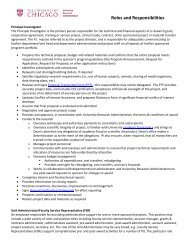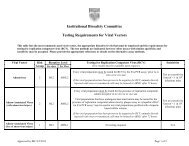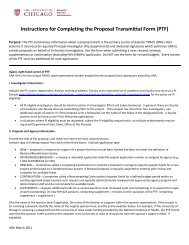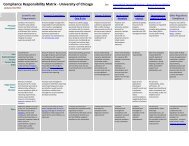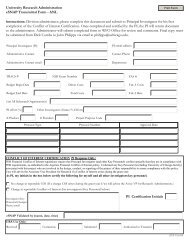Biosafety Considerations for Research with Lentiviral Vectors
Biosafety Considerations for Research with Lentiviral Vectors
Biosafety Considerations for Research with Lentiviral Vectors
Create successful ePaper yourself
Turn your PDF publications into a flip-book with our unique Google optimized e-Paper software.
<strong>Biosafety</strong> <strong>Considerations</strong> <strong>for</strong> <strong>Research</strong> <strong>with</strong> <strong>Lentiviral</strong><strong>Vectors</strong>Recombinant DNA Advisory Committee (RAC) Guidance DocumentBackground: The use of lentiviral vectors has been increasing because the vectorsystem has attractive features; however, such research also raises biosafety issues. TheNIH Office of Biotechnology Activities has received frequent questions regarding theappropriate containment <strong>for</strong> lentiviral vectors, particularly those derived from HIV-1.Because the NIH Guidelines <strong>for</strong> <strong>Research</strong> Involving Recombinant DNA Molecules (NIHGuidelines) do not explicitly address containment <strong>for</strong> research <strong>with</strong> lentiviral vectors, theRAC was asked to provide additional guidance <strong>for</strong> institutional biosafety committees(IBCs) and investigators on how to conduct a risk assessment <strong>for</strong> lentiviral vectorresearch. At the March RAC 2006 meeting, the RAC offered the following findings andrecommendations.Risks of lentivirus vectors: The major risks to be considered <strong>for</strong> research <strong>with</strong> HIV-1based lentivirus vectors are:• Potential <strong>for</strong> generation of replication-competent lentivirus (RCL), and• Potential <strong>for</strong> oncogenesis.These risks can be mitigated by the nature of the vector system (and its safety features)or exacerbated by the nature of the transgene insert encoded by the vector.General criteria <strong>for</strong> risk assessment of lentivirus vectors: Decisions aboutcontainment should take into account a range of parameters/considerations including:• The nature of the vector system and the potential <strong>for</strong> regeneration ofreplication competent virus from the vector components,• The nature of the transgene insert (e.g., known oncogenes or genes <strong>with</strong> highoncogenic potential may merit special care)• The vector titer and the total amount of vector,• The inherent biological containment of the animal host, if relevant,• Negative RCL testing (see section below)General containment considerations: Either BL2 containment or enhanced BL2containment is often appropriate in the laboratory setting <strong>for</strong> research involving the useof advanced lentivirus vector systems that have multiple safety features and thatsegregate vector and packaging functions onto four or more plasmids. Enhanced BL2containment may include in addition to attention to sharps (and use of safety needleswhere feasible), the use of personal protective equipment intended to reduce thepotential <strong>for</strong> mucosal exposure to the vector. In most such research, these levels ofcontainment are also expected to be appropriate even when producing large volumes ofHIV-1 vectors (>10 L).The appropriate containment level <strong>for</strong> specific lentivirus vector research is, of course,determined following a complete risk assessment and local IBC review. The followingsections discuss some considerations which should <strong>for</strong>m an important part of thebiosafety assessment <strong>for</strong> research involving lentivirus vectors.



